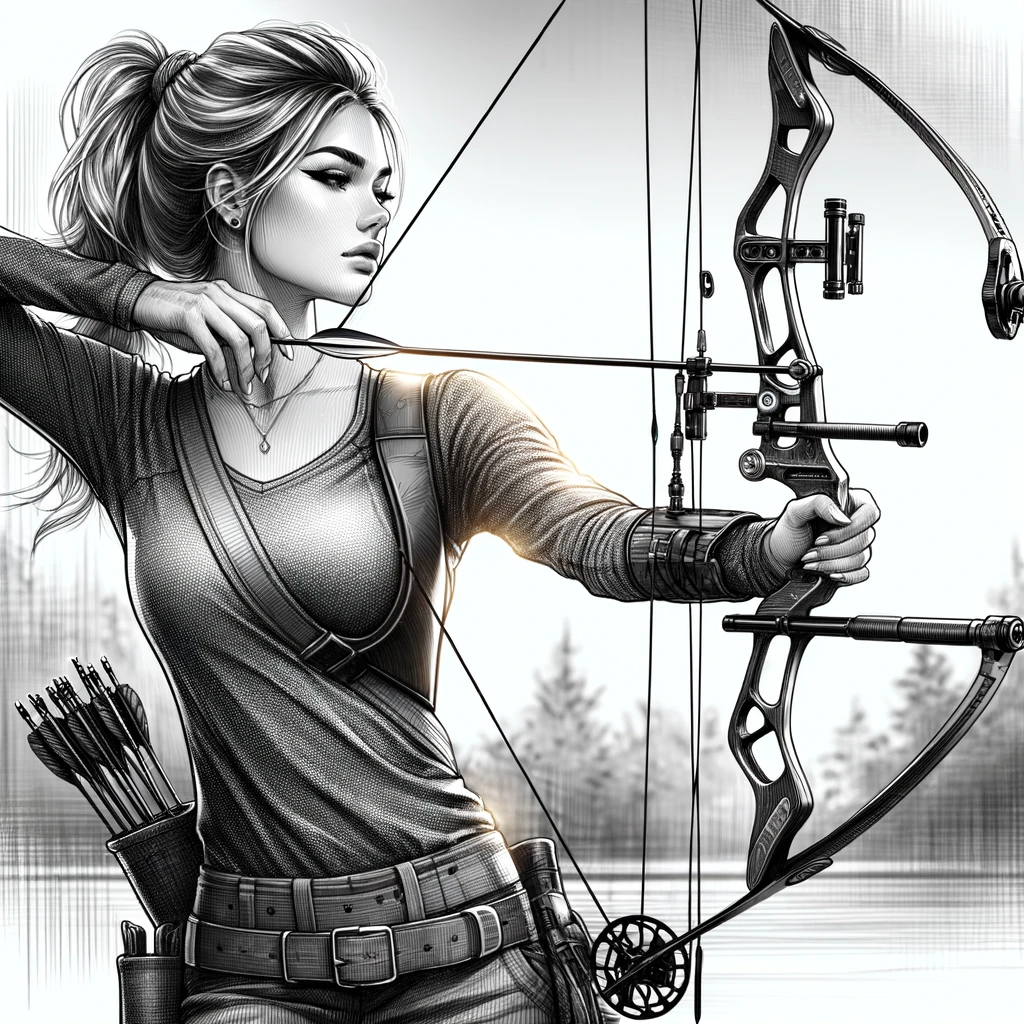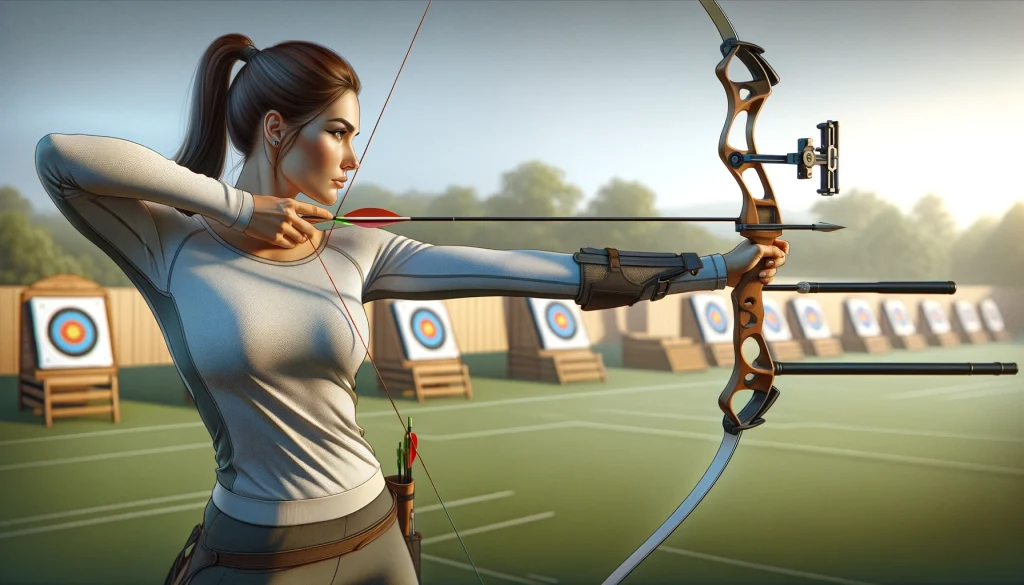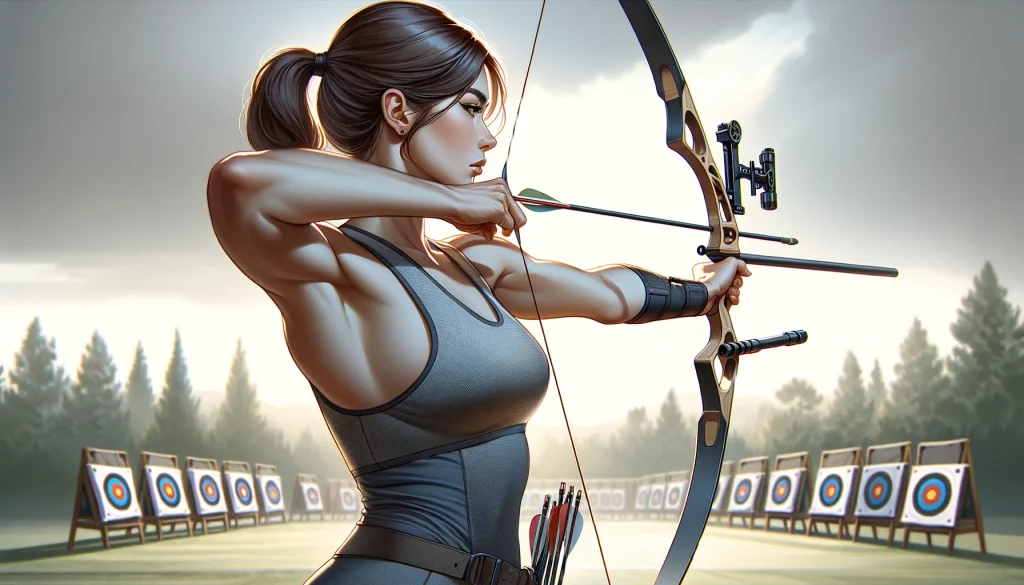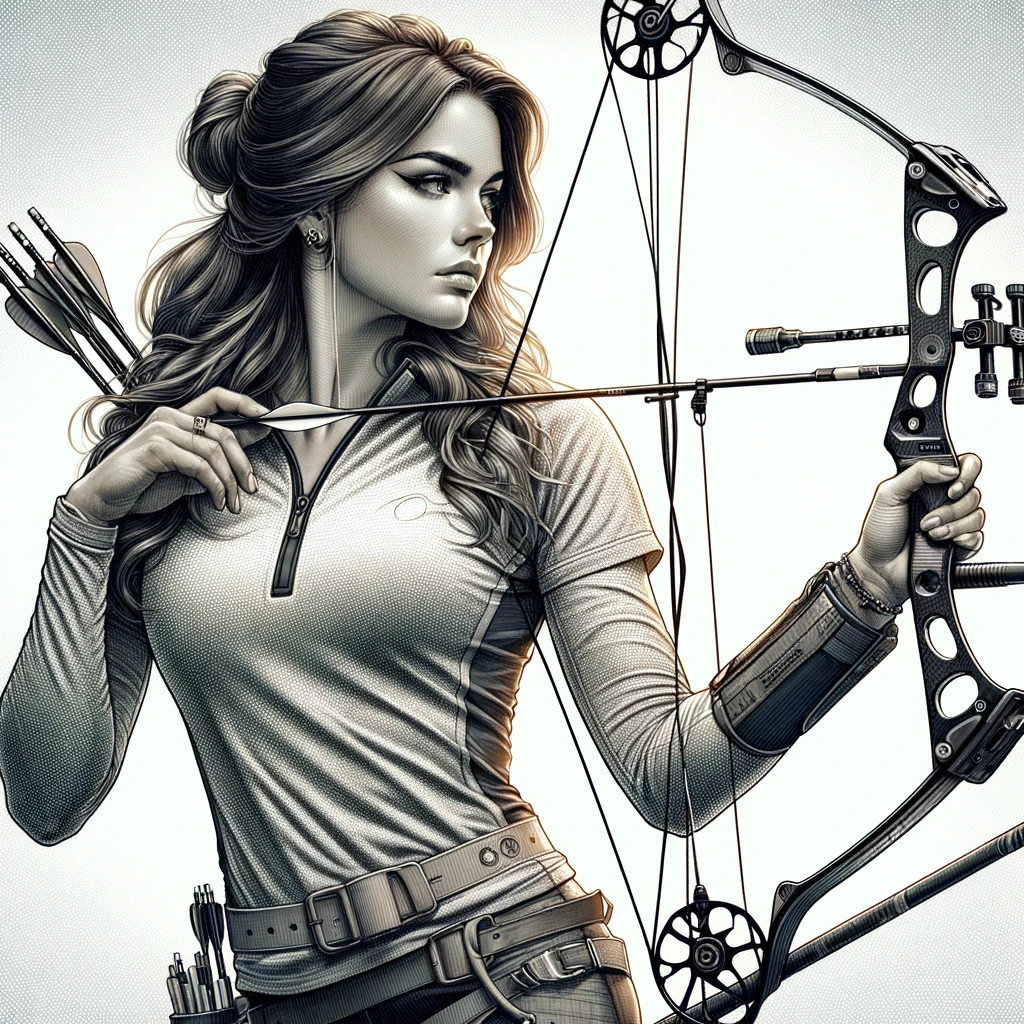
The sport of archery continues to grow in popularity among women, and finding the right equipment is essential to success. Recurve bows are a popular choice for their traditional appeal and elegance, making them ideal for both beginners and experienced archers. This article aims to guide women through the various factors to consider when selecting the best recurve bow, such as draw weight, bow length, and materials.
Draw weight plays a significant role in determining the power and accuracy of your bow, so understanding its importance is crucial to optimizing your archery experience. Bow length and size also factor into the overall performance and comfort of your shooting experience. Additionally, considering takedown bows for their versatility and portability can further enhance your archery journey.
Key Takeaways
- Selecting the right recurve bow involves understanding draw weight, bow length, and materials.
- Takedown bows offer versatility and portability, making them a valuable option for women archers.
- Budget and price considerations are essential to finding the perfect bow for your unique needs and goals.
Selecting the Best Recurve Bow for Women
Female archers seeking the perfect choice in a recurve bow should consider several factors to ensure an enjoyable and successful archery experience. Recurve design is essential, as traditional bows have unique characteristics that cater to women’s needs.
Firstly, consider the bow size. A suitable size not only enhances stability and accuracy but also provides a comfortable user experience. Bow sizes typically range from 48 to 70 inches in length, with women usually finding sizes between 54 to 62 inches ideal. It’s crucial to select a size that matches the archer’s height and arm span.
The draw weight of the bow plays an important role in determining its suitability. For beginners, a draw weight between 15 to 30 pounds is recommended. As the archer becomes more proficient and confident, the draw weight can be increased to offer greater challenge and strength building. Remember that Samick Sage is an excellent choice for beginners due to its lightweight design and 35-pound pull strength.
Another vital aspect is the riser material and quality. Risers are available in various materials such as wood, aluminum alloy, and carbon. Wood risers offer aesthetics and charm, while metal materials provide durability and stability. It’s essential to select a riser that is comfortable in hand, as it impacts the archer’s grip and overall performance.
The type of bow is also important, as there are one-piece and takedown recurve bows. A one-piece recurve bow is crafted from a single piece of wood or material, offering a smoother and more traditional shooting experience. In comparison, a takedown bow can be disassembled, making transportation and storage more convenient. The KESHES 62-inch Takedown Recurve Bow is an excellent choice for those seeking a versatile and portable option.
Lastly, consider the accessories and tools. Many recurve bows come with essential or helpful accessories, such as sights, arrow rests, and string silencers. It helps to ensure that the selected bow includes necessary additions, or is compatible with aftermarket accessories to customize the archery experience.
In conclusion, finding the perfect recurve bow for female archers involves considering factors such as size, draw weight, material, bow type, and accessories. By taking these elements into account, one can make a well-informed decision for an enjoyable and rewarding archery experience.
Understanding Draw Weight

Lower Draw Weight for Beginners
When choosing a recurve bow, it is important to understand the concept of draw weight. Draw weight refers to the amount of force required to pull the bowstring to its full draw. For women just starting with archery, a lower draw weight is often recommended. This typically falls between 20-25 pounds, allowing beginners to focus on learning the basics of archery such as stance, aim, and release without the added stress of managing a heavier draw.
Beginner Recommended:
- Draw Weight: 20-25 pounds
- Focus on: Stance, Aim, Release
A lower draw weight is ideal for mastering technique and allows for longer practice sessions, as less physical effort is expended. The perfect recurve bow for a female beginner should offer comfort, manageability, and room for growth in skill level.
Higher Draw Weights for Experienced Archers
As your proficiency in archery increases, so does the ability to handle higher draw weights. Experienced female archers can comfortably use bows with a draw weight of 30 pounds or more. The increase in draw weight results in faster arrow velocities and greater accuracy at longer distances.
Experienced Recommended:
- Draw Weight: 30 pounds and above
- Focus on: Accuracy, Distance, Arrow Speed
It’s crucial to remember that archery isn’t solely about strength; it’s more about skill and technique. Therefore, beginners should always start with a lower draw weight, gradually increasing the weight as their skill, strength, and endurance improve.
In summary, understanding draw weight is vital in selecting the perfect recurve bow for women. Beginners should opt for a lower draw weight, while more experienced archers may confidently choose a higher draw weight. Ultimately, the choice should always prioritize comfort, skill level, and confidence in handling the bow.
Bow Length and Size
When choosing the best recurve bow for women, it is essential to consider the bow length and size. This section will cover both shorter and longer bows and their advantages.
Shorter Bows for Ease of Handling
Shorter recurve bows are generally recommended for women, as they tend to have shorter draw lengths which can make handling the bow more comfortable. Some shorter bows, like the 58-inch R3, are designed specifically for women and teenagers. A shorter bow length allows for easier maneuverability and can be particularly helpful for beginners or when shooting in tight spaces. It is important to note that shorter bows may sacrifice some stability and power in exchange for their ease of use.
Longer Bows for Stability and Power
Longer recurve bows, on the other hand, offer increased stability and power, although they can be more challenging to handle due to their larger size. Draw length is an important factor in choosing the suitable bow size, as described in the recurve bow length size chart.
Based on your draw length and stature, the chart suggests the following bow lengths:
- 14 to 16 inches: 48 to 54-inch bow
- 20 to 22 inches: 54 to 58-inch bow
- 22 to 24 inches: 58 to 62-inch bow
- 24 to 26 inches: 64 to 66-inch bow
- 26 to 28 inches: 66 to 68-inch bow
- 28 to 30 inches: 68 to 70-inch bow
- Over 31 inches: 70 to 62-inch bow
Using a longer bow can be particularly beneficial for taller women, women with above-average draw lengths, or those striving for more accuracy and power in their shots. The stability provided by a longer bow can make it easier to maintain consistent aim and follow through, which is essential for successful archery.
In conclusion, both shorter and longer recurve bows have their advantages. Choosing the right bow length primarily depends on the archer’s height, draw length, and personal preferences. As mentioned earlier, a recurve bow length size chart can be an important tool to help find the ideal bow size for an individual. By carefully considering these factors, women can find the recurve bow that best suits their needs and leads to an enjoyable and successful archery experience.
Takedown Bows: Versatility and Portability

Ease of Transport with Takedown Design
Takedown bows are a popular choice for many archers, especially women who value both versatility and portability in their equipment. The takedown design consists of three main parts: the riser and two detachable limbs. This feature allows for easy transport and storage, as the bow can be disassembled into smaller pieces, making it an ideal option for those who frequently travel or have limited storage space.
One of the standout advantages of a takedown bow is its ease of use. First-time archers find that assembling and disassembling the bow is straightforward, with the limbs usually attaching to the riser through secure bolts or pins. Some popular takedown bows for women include the Cabelas Warden 62″ and the SAS Courage 60″, both of which have received high praise for their user-friendly designs.
Interchangeable Limbs for Customization
Another key benefit of takedown bows is the ability to customize them to suit individual preferences. With interchangeable limbs, archers have the opportunity to experiment with different draw weights to find the optimal balance for their shooting style and strength. Draw weight is an important factor when choosing a bow, as it affects both the speed and accuracy of the arrow.
Here are some examples of how women can customize their takedown bows using interchangeable limbs:
- Swapping limbs to explore different draw weights for target shooting or hunting
- Experimenting with varying levels of stiffness to tailor the bow to personal shooting style and ability
Popular takedown bows, such as the Hoyt Satori and Samick Sage Archery Takedown Recurve Bow, offer a wide range of limbs to choose from, making customization easier for archers to achieve the perfect setup.
In conclusion, takedown bows provide women archers with a versatile and portable option that caters to their specific needs. The takedown design ensures ease of transport while allowing for a high level of customization through interchangeable limbs. This makes takedown bows a valuable choice for women interested in pursuing archery as a hobby or sport.
Archery Accessories

Choosing the Right Arrow Rest
Selecting the right arrow rest is essential for a woman’s recurve bow setup. Arrow rests are designed to hold the arrow in place on the bow until it is shot. There are various types available, and each has its own benefits. For example, a hip quiver with a belt makes it easy to pull arrows during shooting and allows for customization with colors, designs, and accessories. Choosing an arrow rest that matches your shooting style and preferences will positively impact performance and accuracy.
The Importance of a Bow Stringer
A bow stringer is a vital accessory for safely and efficiently stringing your recurve bow. Using a proper bow stringer reduces the risk of twisting limbs, ensures even force distribution, and improves overall bow performance. A popular and long-lasting option is the Selway Limbsaver Recurve Bow Stringer, which works with any draw weight and features a non-slip rubber construction for secure handling. It is crucial to invest in a reliable and durable bow stringer for women archers.
Using Arm Guards for Protection
Arm guards are essential for safety and comfort while shooting with a recurve bow. They protect the archer’s forearm from the bowstring’s slap, which can cause painful bruising or injury if not properly protected. Arm guards are available in different materials and styles, suiting various preferences and levels of experience. An ideal arm guard provides adequate protection while maintaining comfort and a wide range of motion.
In conclusion, archery accessories such as arrow rests, bow stringers, and arm guards play a pivotal role in women’s recurve bow setups. By being knowledgeable about these items and selecting the right ones for your needs, you can improve your overall archery experience and performance.
Archery Techniques and Form
Mastering Proper Form
Achieving the proper form is essential for anyone looking to perfect their archery skills. Start by standing with your feet shoulder-width apart, parallel to the target. Grip the bow with your non-dominant hand and keep your elbow slightly bent. Hold the string with your middle finger, allowing the other fingers to rest beside it.
When pulling back the string, make sure it reaches full draw, where the bowstring meets the corner of your mouth. Focus on keeping your back muscles engaged and avoid using arm muscles or jerking motions. A proper form ensures accuracy, consistency, and prevents injury. World champion archer Park Sung-Hyun is a great example of perfect archery technique.
Remember to maintain:
- Stance: Feet shoulder-width apart, parallel to the target.
- Grip: Non-dominant hand holding the bow, slightly bent elbow.
- Fingers: Middle finger pulling the string, others resting beside it.
- Draw: Full draw to the corner of the mouth, back muscles engaged.
Finding Consistency with Anchor Points
Consistency is crucial in archery, and anchor points play a significant role in achieving this. Anchor points are the parts of your body that touch the bowstring when at full draw. They help align the bowstring with the archer’s eye, providing a reference for muscle memory and ensuring steady shots.
Common anchor points include:
- The tip of the nose
- The corner of the mouth
- The jawline
- The cheekbone
Finding the perfect anchor points boils down to personal preference and comfort. Practice these points regularly to develop muscle memory for consistent and accurate shots. Remember, perfecting one’s form and mastering anchor points is crucial for all archers, especially those looking into using recurve bows designed for women, such as the Samick Sage Takedown Recurve Bow.
Choosing Arrows
Carbon Arrows for Speed and Precision
Carbon arrows are the go-to choice for many archers, as they offer optimal speed and precision. These arrows are lightweight, which allows them to travel faster and more accurately than their counterparts. They also exhibit exceptional durability and are less prone to bending or breaking, making them a reliable option for consistent shooting performance. Additionally, carbon arrows are known for their relatively low amount of force required for a shot, which can be particularly beneficial for women who may have a lower draw weight on their recurve bow.
Arrow Weight and Spine Compatibility
When selecting arrows for a recurve bow, it is crucial to consider both the arrow’s weight and spine compatibility. Arrow weight plays a significant role in the amount of force required to propel the arrow and achieve proper penetration, while arrow spine refers to the stiffness of the shaft and affects the overall accuracy of the shot.
To find the right combination of arrow weight and spine compatibility, consider the following steps:
- Determine your bow’s draw weight: This is essential, as it directly impacts the arrow’s weight and spine required for optimal performance. You can typically find the draw weight listed on the bow’s limbs or manufacturers’ specifications.
- Choose the appropriate arrow weight: Heavier arrows tend to generate more force, which can improve penetration and overall performance. However, they also require more energy to propel, which may not be suitable for all archers. Lighter arrows, such as carbon arrows, offer improved speed and accuracy but may sacrifice some penetration.
- Match arrow spine with draw weight: To ensure you have the right balance between arrow weight and spine, consult a spine selection chart or ask for guidance from an experienced archer or professional at an archery store.
In summary, the ideal arrow for a recurve bow should provide a well-balanced combination of speed, accuracy, and force. The arrow’s weight and spine compatibility should also match the draw weight of your recurve bow, ensuring optimal performance. By considering these factors and opting for carbon arrows, a woman can experience a comfortable and efficient shooting experience.
Bow Materials and Craftsmanship
Benefits of Wooden Risers
Wooden risers, often made from hardwood, offer a traditional and visually appealing option for recurve bows. One of the well-known wooden recurve bows is the Samick Sage, which is ideal for beginners. Wooden risers provide a warm, comfortable grip and ensure a natural, classic archery experience.
Some advantages of using wooden risers include:
- Aesthetic appeal: The organic look of wooden bows attracts many archers.
- Durability: Hardwood risers can withstand extensive use and harsh conditions.
- Price: Typically, wooden bows are more affordable than their metal counterparts.
- Comfort: Wooden risers provide a comfortable grip, reducing hand fatigue during extended practice sessions.
However, wooden risers may not be the best option for those looking for maximum customization or modern performance enhancements offered by metal risers.
Metal Risers and Modern Materials
Metal risers, often made from aluminum or magnesium alloys, have become increasingly popular in the world of competitive archery due to their adaptability and performance-enhancing features. The TOPARCHERY 56-Inch Takedown Recurve Bow and the Hoyt Satori are examples of recurve bows with metal risers.
Key benefits of using metal risers include:
- Customization: Metal risers often support the International Limb Fitting (ILF) system, allowing for easy limb interchangeability and adjustability.
- Consistency: Metal risers provide increased consistency due to their rigidity, which can lead to improved accuracy for the archer.
- Weight distribution: Modern materials allow for optimal weight distribution across the bow, contributing to better balance and stability.
- Performance enhancements: Metal risers may incorporate vibration dampening technology, reducing hand shock and improving accuracy.
Although metal risers offer numerous advantages, they might not be suitable for archers looking for a more traditional archery experience or those with budget constraints, as they are typically more expensive than wooden bows.
When choosing between a wooden or metal riser, it’s essential to consider your personal preferences, budget, and archery goals. Both materials have their benefits and drawbacks, but ultimately, the best recurve bow for you will depend on your individual needs and preferences.
Bow Features for Women
Smooth Draw Cycles for Comfort
A recurve bow with a smooth draw cycle is crucial for female archers. It provides a comfortable experience while shooting, minimizing fatigue and allowing for better control. One example of a recurve bow with a smooth draw cycle is the Samick Sage Takedown Recurve Bow. A bow’s smoothness can also be affected by its brace height, which is the distance between the bow’s string and the grip when the bow is at rest. A higher brace height typically results in a smoother draw.
Adjustable Sights for Accuracy
For improved accuracy, a recurve bow should have adjustable sights that allow female archers to fine-tune their aim. Adjustable sights help archers find the best shooting angles for their bows. For instance, the KESHES 62-inch Takedown Recurve Bow offers adjustable sights to help ensure precise shots.
Adjustable sights are especially important for beginners, as they allow new archers to learn and improve their shooting techniques.
| Feature | Importance |
|---|---|
| Smooth draw cycle | Comfort and control |
| Adjustable sights | Better accuracy and precision |
| Lightweight design | Increased maneuverability |
Lightweight Bows for Maneuverability
When selecting a recurve bow for women, finding a lightweight option is particularly crucial. A lightweight bow is easier to handle and maneuver, minimizing exhaustion during extended practice sessions or hunting trips. An example of a lightweight bow is the SAS Junior 58-Inch Takedown Recurve Bow, which is suitable for beginners due to its user-friendly design.
In addition to these primary features, a recurve bow with a comfortable finger tab can help female archers protect their fingers from the string as they shoot. This added protection contributes to a more enjoyable archery experience overall.
Budget and Price Considerations
When considering the best recurve bow for women, it’s important to factor in budget and price considerations. There are various aspects to keep in mind when deciding on a recurve bow that suits your needs and budget.
Understanding Price Range
Recurve bows can come at various price points, depending on factors such as materials, brand, and accessories included. Generally, they can be categorized into three price ranges:
- Low-end: These recurve bows are usually priced under $150 and cater to beginners or those looking for an affordable option for occasional use. They may not provide the best performance or durability, but they serve as a good starting point for newcomers to archery.
- Mid-range: Bows in this category fall within the $150 to $300 price range and are a great choice for intermediate archers who want to invest in a better-quality bow. These bows typically offer better performance and materials than low-end options while still remaining reasonably priced.
- High-end: Ranging from $300 and above, these premium bows are an excellent choice for advanced archers or those who prioritize performance and quality. This category of bows often features high-quality materials, cutting-edge technology, and customizable options.
Value for Money in Bow Selection
To make the best decision, weigh the benefits of each bow against its price point. A few factors to consider include:
- Materials: The quality of materials used in the construction of the bow has a significant impact on its performance and durability. Higher-end bows are typically made with lighter, more advanced materials that provide better shooting experience and last longer.
- Performance: An archer should consider the bow’s accuracy, speed, and ease of use. High-quality recurve bows typically have better, more consistent performance. It is important not to compromise on performance, as this is a crucial element of archery.
- Accessories: Some recurve bows come with accessories such as sights, stabilizers, or bowstrings. These extras can influence the value for money of a bow, especially if they’re of high quality and enhance the archer’s experience.
- Purpose: The intended use for the recurve bow also plays a role in determining its value for money. For instance, a casual archer may find a low or mid-range bow to be a good choice, while someone who plans to participate in competitions might prioritize a high-end option.
In conclusion, selecting the best recurve bow for women involves considering both the price range and the value for money it offers. By evaluating the materials, performance, accessories, and intended purpose, archers can make an informed decision that suits their needs and budget.
Frequently Asked Questions
What factors should women consider when choosing a recurve bow?
When choosing a recurve bow, women should consider factors such as draw weight, bow length, and materials used in construction. It’s important to select a bow with a comfortable draw weight that aligns with the archer’s skill level. Additionally, the overall bow length should be suitable for the user’s height and arm length. Lastly, quality materials like wood or metal will ensure durability and performance.
How does draw weight affect a woman’s shooting experience with a recurve bow?
Draw weight is the force required to pull the bowstring to a full draw. It directly affects the arrow’s speed and power. Women should choose a recurve bow with a suitable draw weight that enables them to shoot comfortably and accurately. A lighter draw weight may be more suitable for beginners, while more experienced archers can opt for a heavier draw weight.
Which recurve bows are recommended for women beginners?
For women beginners, some recommended recurve bows include the Samick Sage Takedown and the Western Archery The Edge. These bows offer good performance, affordability, and user-friendly features that make them suitable for new archers.
What is the ideal recurve bow size for women based on their height?
The ideal recurve bow size depends on the archer’s height and arm length. One can use a general guideline to determine the suitable bow size: individuals shorter than 5’6″ could use a 64-inch bow, individuals between 5’6″ and 5’10” might consider a 66-inch bow, and those taller than 5’10” may find a 68-inch bow suitable.
Can women use competition recurve bows for hunting purposes?
Yes, women can use competition recurve bows for hunting purposes; however, it’s essential to consider the bow’s draw weight, size, and suitability for hunting conditions. Bows with higher draw weights will provide sufficient power to take down game effectively.
What are the top-rated recurve bows for women in the current market?
Some top-rated recurve bows for women include the Samick Sage Takedown, KESHES 62-inch Takedown Recurve Bow, and Bear Archery Grizzly. These bows have been praised for their performance, durability, and overall user satisfaction.
